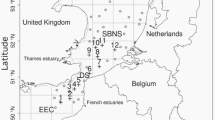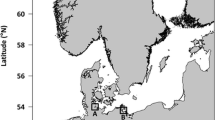Synopsis
Feeding and growth rates of 1–3 wk old herring larvae from four different stocks were compared in laboratory experiments (8°C). For most of the larval groups, feeding rate was saturated at nauplii (Acartia tonsa, nauplii stages 3–5) densities over 301−1 (5 μg d.w. 1−1). Specific growth rate increased asymptotically with nauplii density, and reached about 6% d−1 at densities over 120 nauplii 1−1. The growth rates attained in the laboratory were similar to field measured growth rates of similarly aged herring larvae at comparable food densities. Since food particles were homogenously distributed in the laboratory tanks, patches of dense plankton concentrations are, thus, apparently not necessary for larval growth and survival in the sea. Growth efficiency differed between larval groups, with large sized larvae being the most efficient in transforming ingested matter into growth. The difference probably relates to different sizes rather than to the different geographical origins of the larvae.
Similar content being viewed by others
References cited
Athur, K.D. 1977. Distribution, size, and abundance of microcopepods in the California current system and their possible influence on the survival of marine teleost larvae. U.S. Fish. Bull. 75: 601–611.
Benijts, F., E. van Voorden & P. Sorgeloos. 1975. Changes in the biochemical composition of the early stages of the brine shrimps,Artemia salina L. 10th Europ. Symp. Mar. Biol. 1: 1–9.
Checkley, D.M. Jr. 1982. Selective feeding by Atlantic herring (Clupea harengus) larvae on zooplankton in natural assemblages. Mar. Ecol. prog. ser. 9: 245–253.
Checkley, D.M. Jr. 1984. The relation of growth to ingestion for larvae of Atlantic herring,Clupea harengus, and other fish. Mar. Ecol. prog. ser. 18: 215–224.
De Silva, C.D. & P. Tytler. 1973. The influence of reduced environmental oxygen on the metabolism and survival of herring and plaice larvae. Neth. J. Sea Res. 7: 345–362.
Gamble, J.C., P. MacLachlan, N.T. Nicholl & I.G. Baxter. 1981. Growth and feeding of Atlantic herring larvae reared in large plastic enclosures. Rapp. p.-v. Réun. Cons. int. Explor. Mer. 178: 121–134.
Geffen, A.J. 1982. Otolith ring deposition in relation to growth rate in herring (Clupea harengus) and turbot (Scophthalmus maximus) larvae. Mar. Biol. 71: 317–326.
Haegele, C.W. & D.N. Outram. 1978. The effect of diet and ration on the growth and survival of Pacific herring (Clupea harengus pallasi) larvae. Fish. Mar. Ser. Can. Tech. Rep. 767. 41 pp.
Holliday, F.G.T., J.H.S. Blaxter & R. Lasker. 1964. Oxygen uptake of developing eggs and larvae of herring. J. mar. biol. Ass. U.K. 44: 711–723.
Houde, E.D. & R.C. Schekter. 1981. Growth rates. rations and cohort consumption of marine fish larvae in relation to prey concentration. Rapp. P.-v. Réun. Cons. Int. Explor. Mer. 178: 441–453.
Houde, E.D. & R.C. Schekter. 1983. Oxygen uptake and comparative energetics among eggs and larvae of three subtropical marine fishes. Mar. Biol. 72: 283–293.
Hunter, J.R. & G.L. Thomas. 1974. Effect of prey distribution and density on the searching and feeding behaviour of larval anchovyEngraulis mordax Girard. pp. 559–574.In: Blaxter, J.H.S. (ed.) The Early Life History of Fish, Springer, Berlin.
Kiörboe, T., P. Munk & J.G. Støttrup. 1985. First feeding by larval herringClupea harengus L. Dana 5: 95–107.
Lasker, R. 1975. Field criteria for survival of anchovy larvae: the relation between inshore chlorophyll maximum layers and successful first feeding. U.S. Fish. Bull. 73: 453–462.
Lasker, R. & G.H. Theilacker. 1962. Oxygen consumption and osmoregulation by single pacific sardine eggs and larvae. J. Cons. int. Explor. Mer. 27: 25–33.
Lasker, R. & J.R. Zweifel. 1978. Growth and survival of first feeding northern anchovy larvae (Engraulis mordax) in patches containing different proportions of large and small prey. pp. 329–354.In: Steele, J.H. (ed.) Spatial Pattern in Plankton Communities, Plenum Publishing, New York.
McGurk, M.D. 1984a. Effects of delayed feeding and temperature on the age of irreversible starvation and on the rates of growth and mortality of Pacific herring larvae. Mar. Biol. 84: 13–26.
McGurk, M.D. 1984b. Ring deposition in the otoliths of larval Pacific herring,Clupea harengus pallasi. U.S. Fish. Bull. 82: 91–98.
Munk, P. & V. Christensen. 1983. Distribution of herring larvae at Aberdeen Bank, Buchan area, September 1983. International Council for the Exploration of the Sea, Council meeting 1984/L: 22.
Munk, P. & H.H. Hansen. 1980. Growth and survival of larval turbot (Scophthalmus maximus). M.Sc. Thesis, Danish Institute for Fisheries and Marine Research, Charlottenlund. 73 pp. (In Danish).
Munk, P. & T. Kiørboe. 1985. Feeding behaviour and swimming activity of larval herring (Clupea harengus L.) in relation to density of copepod nauplii. Mar. Ecol. prog. ser. 24: 15–21.
Munk, P. & H. Rosenthal. 1983. Variability in the size of herring larvae at hatching. Influence of egg density and parental material. International Council for the Exploration of the Sea, Council meeting 1983/L: 33.
Schnack, D. 1981. Studies on the mortality of Pacific herring larvae during their early development, usingin situ containers. Rapp. P.-v. Réun. Cons. int. Explor. Mer. 178: 135–142.
Støttrup, J.G. & P. Munk. 1983. Cultivation techniques for producing copepods as food for fish larvae. International Council for the Exploration of the Sea, Council meeting 1983/F: 20.
Talbot, G.B. & S.I. Johnson. 1972. Rearing Pacific herring in the laboratory. Prog. Fish. Cult. 34: 2–7.
Werner, R.G. & J.H.S. Blaxter. 1980. Growth and survival of larval herring (Clupea harengus) in relation to prey density. Can. J. Fish. Aquat. Sci. 37: 1063–1069.
Øiestad. V. 1983. Growth and survival of herring larvae and fry (Clupea harengus L.) exposed to different feeding regimes in experimental ecosystems: outdoor basins and plastic bags. Ph.D. Thesis, Institute of Marine Research, Bergen. 299 pp.
Author information
Authors and Affiliations
Rights and permissions
About this article
Cite this article
Kiørboe, T., Munk, P. Feeding and growth of larval herring,Clupea harengus, in relation to density of copepod nauplii. Environ Biol Fish 17, 133–139 (1986). https://doi.org/10.1007/BF00001743
Received:
Accepted:
Issue Date:
DOI: https://doi.org/10.1007/BF00001743




